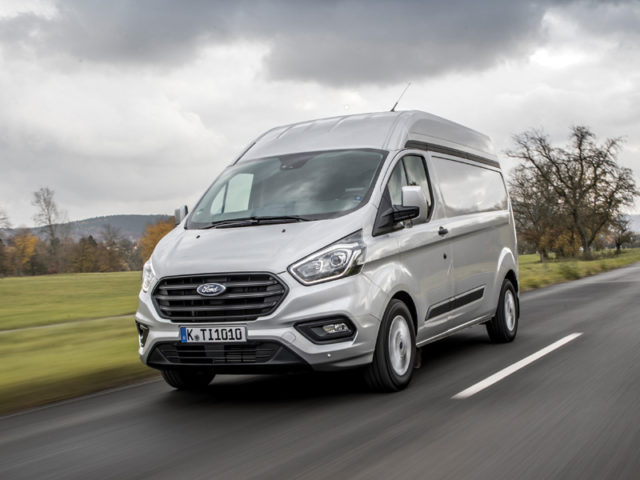Ford has started an 18-month renewal of its LCV line-up with an update to Custom, says Dan Gilkes.
SECTOR Medium LOAD VOLUME 6.0m3-8.3m3 POWER 105-170hp GROSS WEIGHT 2.8-3.2 tonnes
It seems incredible that Ford’s Transit Custom has already been in for its first nip and tuck update. However, the mid-weight Custom, originally launched in 2012, has been a massive success for Ford and the company is keen to maintain its position as Europe’s top selling van.
Externally the changes are relatively subtle, with a three-bar grille dominating the front end. There are distinctive LED daytime running lights on higher trim models, with Xenon headlights also on offer. The sliding side door track is now smoothly integrated into the sheet metal, but otherwise the working end of the van is unchanged, with the same range of short and long wheelbases offered in standard and high roof versions.
The new look is more noticeable inside the cab, with a completely new dash and instrument panel. Ford claims class-leading storage, with three open bins on top of the dash and revised door pulls opening up space for an additional door shelf.
The dash displays and infotainment depend on specification and trim level, with base models getting a regular single-DIN stereo with no connectivity. Next up is a connected radio, allowing mobile phone use, which comes with the MyFord Dock in the centre of the dash for smartphone charging.
Ford’s SYNC infotainment system is offered in three levels, starting with a SYNC Lite system using a 4.0-inch display. There is also a SYNC system with no navigation and then the full-fat SYNC 3 communications and entertainment offering, which includes an 8.0-inch touchscreen and full connectivity, including Apple CarPlay and Android Auto.
Ford had already introduced its EcoBlue 2.0-litre Euro 6 engine in Custom, in 105bhp, 130bhp and 170bhp variants. The van is now also offered with an ECOnetic version of the 105bhp short wheelbase model, with unique calibration, Auto-Stop-Start, low rolling resistance tyres, Acceleration Control and a 62mph speed limiter. The ECOnetic van boasts a 6% improvement in fuel efficiency over the standard 105hp model, at 49.6mpg, with 148g/km of CO2.
A six-speed manual gearbox is standard, driving through the front wheels, though the six-speed Selectshift automatic transmission is offered on the two higher horsepower engines. Ford admits to some surprise with the high take-up of this auto box, which now accounts for around 12% of Custom van sales in the UK and up to 33% of Tourneo people carriers.
The diesel vans will be joined by a PHEV hybrid in 2019. This uses Ford’s 1.0-litre EcoBoost petrol engine as a range extender, to offer a 310-mile range, with 30 miles of electric-only running. The compact petrol engine and small liquid-cooled lithium-ion battery contribute to a payload in excess of 1-tonne, with no loss of load volume.
Ford is offering a host of driver assistance systems on Custom, though the lack of electric steering has ruled out self-parking and steering assistance for the moment. A first for the van is Intelligent Speed Assist, which uses Traffic Sign Recognition to automatically set the van’s maximum speed within legal limits.
What we think
While certainly not a groundbreaking model change, the updates to Custom should keep Ford’s mid-weight on the shopping list for many fleet buyers.


